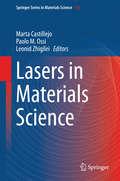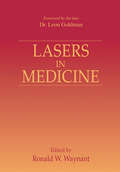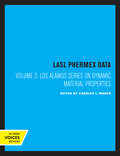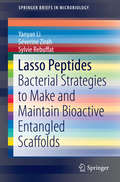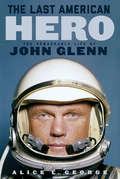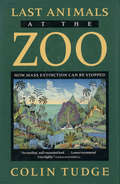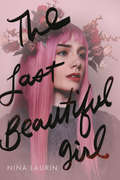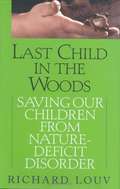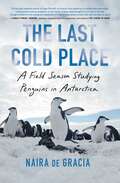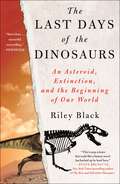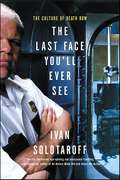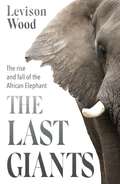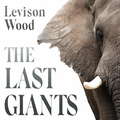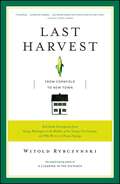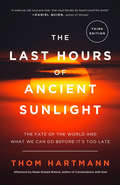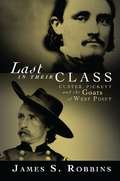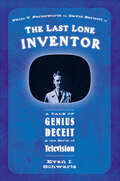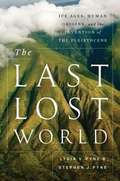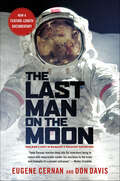- Table View
- List View
Lasers in Dentistry—Current Concepts (Textbooks in Contemporary Dentistry)
by Donald J. Coluzzi Steven P. A. ParkerThis book, now in an extensively revised second edition, provides information on the basic science and tissue interactions of dental lasers and documents the principal current clinical uses of lasers in every dental discipline. The applications of lasers in restorative dentistry, endodontics, dental implantology, pediatric dentistry, periodontal therapy, and soft tissue surgery are clearly described and illustrated. Information is also provided on laser-assisted multi-tissue management, covering procedures such as crown lengthening, gingival troughing, gingival recontouring, and depigmentation. The closing chapters look forward to the future of lasers in dentistry and the scope for their widespread use in everyday clinical practice. When used in addition to or instead of conventional instrumentation, lasers offer many unique patient benefits. Furthermore, research studies continue to reveal further potential clinical applications, and new laser wavelengths are being explored, developed, and delivered with highly specific power configurations to optimize laser–tissue interaction. This book will bring the reader up to date with the latest advances and will appeal to all with an interest in the application of lasers to the oral soft and/or hard tissues.
Lasers in Materials Science
by Marta Castillejo Paolo M. Ossi Leonid ZhigileiThis book covers various aspects of lasers in materials science, including a comprehensive overview on basic principles of laser-materials interactions and applications enabled by pulsed laser systems. The material is organized in a coherent way, providing the reader with a harmonic architecture. While systematically covering the major current and emerging areas of lasers processing applications, the Volume provides examples of targeted modification of material properties achieved through careful control of the processing conditions and laser irradiation parameters. Special emphasis is placed on specific strategies aimed at nanoscale control of material structure and properties to match the stringent requirements of modern applications. Laser fabrication of novel nanomaterials, which expands to the domains of photonics, photovoltaics, sensing, and biomedical applications, is also discussed in the Volume. This book assembles chapters based on lectures delivered at the Venice International School on Lasers in Materials Science which was held in Isola di San Servolo, Venice, Italy, in July, 2012.
Lasers in Medicine
by Ronald W. WaynantThe use of lasers in medical practice has dramatically increased over the years. Lasers and modern optics have largely been unexplored in medical science. This contributed work is both optimistic and cautionary in its expert evaluation of the state-of-the-art medical use of laser technology. The use of lasers to improve upon conventional practice i
LASL Phermex Data, Vol. III (Los Alamos Scientific Laboratory Series on Dynamic Material Properties)
by Charles L. MaderThis title is part of UC Press's Voices Revived program, which commemorates University of California Press’s mission to seek out and cultivate the brightest minds and give them voice, reach, and impact. Drawing on a backlist dating to 1893, Voices Revived makes high-quality, peer-reviewed scholarship accessible once again using print-on-demand technology. This title was originally published in 1980.
Lasso Peptides
by Yanyan Li Séverine Zirah Sylvie RebuffatLasso peptides form a growing family of fascinating ribosomally-synthesized and post-translationally modified peptides produced by bacteria. They contain 15 to 24 residues and share a unique interlocked topology that involves an N-terminal 7 to 9-residue macrolactam ring where the C-terminal tail is threaded and irreversibly trapped. The ring results from the condensation of the N-terminal amino group with a side-chain carboxylate of a glutamate at position 8 or 9, or an aspartate at position 7, 8 or 9. The trapping of the tail involves bulky amino acids located in the tail below and above the ring and/or disulfide bridges connecting the ring and the tail. Lasso peptides are subdivided into three subtypes depending on the absence (class II) or presence of one (class III) or two (class I) disulfide bridges. The lasso topology results in highly compact structures that give to lasso peptides an extraordinary stability towards both protease degradation and denaturing conditions. Lasso peptides are generally receptor antagonists, enzyme inhibitors and/or antibacterial or antiviral (anti-HIV) agents. The lasso scaffold and the associated biological activities shown by lasso peptides on different key targets make them promising molecules with high therapeutic potential. Their application in drug design has been exemplified by the development of an integrin antagonist based on a lasso peptide scaffold. The biosynthesis machinery of lasso peptides is therefore of high biotechnological interest, especially since such highly compact and stable structures have to date revealed inaccessible by peptide synthesis. Lasso peptides are produced from a linear precursor LasA, which undergoes a maturation process involving several steps, in particular cleavage of the leader peptide and cyclization. The post-translational modifications are ensured by a dedicated enzymatic machinery, which is composed of an ATP-dependent cysteine protease (LasB) and a lactam synthetase (LasC) that form an enzymatic complex called lasso synthetase. Microcin J25, produced by Escherichia coli AY25, is the archetype of lasso peptides and the most extensively studied. To date only around forty lasso peptides have been isolated, but genome mining approaches have revealed that they are widely distributed among Proteobacteria and Actinobacteria, particularly in Streptomyces, making available a rich resource of novel lasso peptides and enzyme machineries towards lasso topologies.
The Last American Hero: The Remarkable Life of John Glenn
by Alice L. GeorgeOn February 20, 1962, John Glenn became a national star. That morning at Cape Canaveral, a small-town boy from Ohio took his place atop a rocket and soared into orbit to score a victory in the heavily contested Cold War. The television images were blurry black-and-white phantoms. The cameras shook as the rocket moved, but by the end of the day, one thing was clear: a new hero rode that rocket and became the center of the world's attention for the four hours and fifty-five minutes of his flight. He became celebrated in all corners of the world as not just the first American to orbit the Earth, but as the first space traveler to take the human race with him. From that day forward, Glenn restively wore the hero label. Wherever he went, people knew his name and what he had done. Refusing to let that dramatic day define his life, he went on to become a four-term US senator—and returned to space at the age of seventy-seven. The Last American Hero examines the many layers that formed the man and unravels the reasons for his singular role. He was a creation of the media, in some ways, but he was also a product of the Cold War. Not even Glenn himself seemed to fully understand his celebrity. He was a war hero, a two-time astronaut, a veteran senator, a devoted husband, a father, and much more. At a time when increasingly cynical Americans need heroes, his aura burns brightly in American memory.
Last Animals at the Zoo: How Mass Extinction Can Be Stopped
by Colin TudgeIn Last Animals at the Zoo, Colin Tudge argues that zoos have become an essential part of modern conservation strategy, and that the only real hope for saving many endangered species is through creative use of zoos in combination with restoration of natural habitats. From the genetics of captive breeding to techniques of behavioral enrichment, Tudge examines all aspects of zoo conservation programs and explains how the precarious existence of so many animals can best be protected.
The Last Beautiful Girl
by Nina LaurinFans of Black Mirror and There's Someone Inside Your House will devour this disturbing story about a dark descent into social media fame. Izzy is determined to use her family's new mansion, and the treasures inside, to outshine everyone in her new town, even when it's clear that something—or someone—in the house has deadly intentions...When Isabella Brixton is forced to move from New York City to a tiny town, she's not thrilled. The silver lining is the gorgeous old mansion she now calls home. As the former residence of a glamorous patron of the arts and muse who died many decades ago, the house has its quirks: whole floors are boarded up, old paintings are covered, and cell reception is nonexistent.Isa is ready to hate her new life, but things turn around when her classmate Alexa, a skilled photographer, suggests they start an Instagram account featuring portraits of Isa inside the mansion. Wearing gowns and jewelry hidden away in the house, Isa looks perfect in the unfiltered photos—almost unnaturally so—and they quickly go viral. Soon she's got a new best friend, a potential boyfriend, and is surrounded by a group of girls who want the photoshoots and fame for themselves. But there's a darkness in the house, and a darkness growing in Isa, too. When girls start getting hurt, it's clear that something—or someone—in the house is growing in power, with deadly intentions.
Last Breath: The Limits of Adventure
by Peter StarkSudden, extreme deaths have always fascinated us-- and now more than ever as athletes and travelers rise to the challenges of high-risk sports and journeys on the edge. In this spellbinding book, veteran travel and outdoor sports writer Peter Stark reenacts the dramas of what happens inside our bodies, our minds, and our souls when we push ourselves to the absolute limits of human endurance. Combining the adrenaline high of extreme sports with the startling facts of physiological reality, Stark narrates a series of outdoor adventure stories in which thrill can cross the line to mortal peril. Each death or brush with death is at once a suspense story, a cautionary tale, and a medical thriller. Stark describes in unforgettable detail exactly what goes through the mind of a cross-country skier as his body temperature plummets-- apathy at ninety-one degrees, stupor at ninety. He puts us inside the body of a doomed kayaker tumbling helplessly underwater for two minutes, five minutes, ten minutes. He conjures up the physiology of a snowboarder frantically trying not to panic as he consumes the tiny pocket of air trapped around his face under thousands of pounds of snow. These are among the dire situations that Stark transforms into harrowing accounts of how our bodies react to trauma, how reflexes and instinct compel us to fight back, and how, why, and when we let go of our will to live.In an increasingly tamed and homogenized world, risk is not only a means of escape but a path to spirituality. As Peter Stark writes, "You must try to understand death intimately and prepare yourself for death in order to live a full and satisfying life." In this fascinating, informative book, Stark reveals exactly what we’re getting ourselves into when we choose to live-- and die-- at the extremes of endurance.
Last Breath
by Peter Stark"Forget the edge of your seat. Last Breathtakes you to the edge of your life, for a pulse-pounding glimpse into the Great Beyond. There are many ways to risk your life in the out-of-doors, and Stark has captured them in exquisite and harrowing detail. " -JIM ROBBINS Author ofA Symphony in the Brain An enthralling blend of adventure and science, Last Breath re-creates in heart-stopping detail what happens to our bodies and our minds in the perilous last moments of life when an extreme adventure goes awry. Combining the adrenaline high of extreme sports with the startling facts of physiological reality, veteran travel and outdoor sports writer Peter Stark narrates a series of adventure stories in which thrill can cross the line to mortal peril. Each death or brush with death is at once a suspense story, a cautionary tale, and a medical thriller. Will they survive, or will they succumb? Readers will shiver with a man lost in the snowy woods, suffering from hypothermia and tearsing off his clothes as he's burning up from the cold; they will hallucinate with a young woman stranded at the top of Annapurna as she experiences a cerebral edema; and while a kayaker tumbles helplessly underwater for two minutes, five minutes, ten minutes, readers, too, will gasp for their last breath.
The Last Butterflies: A Scientist's Quest to Save a Rare and Vanishing Creature
by Nick HaddadA remarkable look at the rarest butterflies, how global changes threaten their existence, and how we can bring them back from near-extinctionMost of us have heard of such popular butterflies as the Monarch or Painted Lady. But what about the Fender’s Blue? Or the St. Francis’ Satyr? Because of their extreme rarity, these butterflies are not well-known, yet they are remarkable species with important lessons to teach us. The Last Butterflies spotlights the rarest of these creatures—some numbering no more than what can be held in one hand. Drawing from his own first-hand experiences, Nick Haddad explores the challenges of tracking these vanishing butterflies, why they are disappearing, and why they are worth saving. He also provides startling insights into the effects of human activity and environmental change on the planet’s biodiversity.Weaving a vivid and personal narrative with ideas from ecology and conservation, Haddad illustrates the race against time to reverse the decline of six butterfly species. Many scientists mistakenly assume we fully understand butterflies’ natural histories. Yet, as with the Large Blue in England, we too often know too little and the conservation consequences are dire. Haddad argues that a hands-off approach is not effective and that in many instances, like for the Fender’s Blue and Bay Checkerspot, active and aggressive management is necessary. With deliberate conservation, rare butterflies can coexist with people, inhabit urban fringes, and, in the case of the St. Francis’ Satyr, even reside on bomb ranges and military land. Haddad shows that through the efforts to protect and restore butterflies, we might learn how to successfully confront conservation issues for all animals and plants.A moving account of extinction, recovery, and hope, The Last Butterflies demonstrates the great value of these beautiful insects to science, conservation, and people.
Last Chance to Live
by Younan NowzaradanDr. Nowzaradan has dedicated much of his career to advocating quality medical management for the obese. While others were limiting weight loss surgery to those who weighed under 300-lbs., he was already performing safe laparoscopic weight loss surgery on super morbid obese individuals who weighed in excess of 600-lbs. Dr. Nowzaradan firmly believes in the care of the obese without discrimination or prejudice. In 2003, he performed laparoscopic weight loss surgery on the world's heaviest dad, heaviest mom, and heaviest teen. He has been featured in the hit TLC shows "Half Ton Killer," as well as "My 600-lb. Life," with the hope of influencing the public and the medical community to change their bias and negative opinion regarding severely obese individuals. Dr. Nowzaradan has become a beacon of hope for those who have struggled with their weight. He has changed the lives of many when others weren't willing to help them. As a doctor, he always helps to heal those that need it most.
Last Child in the Woods: Saving Our Children from Nature-Deficit Disorder
by Richard LouvFrom the Book Jacket: "I like to play indoors better 'cause that's where all the electrical outlets are," reports a fourth-grader. Never before in history have children been so plugged-in-and so out of touch with the natural world. In this groundbreaking new work, child advocacy expert Richard Louv direcdy links the lack of nature in the lives of today's wired generation-he calls it nature deficit-to some of the most disturbing childhood trends, such as rises in obesity, Attention Deficit Disorder (ADD), and depression. Some startling facts: By the 1990s the radius around the home where children were allowed to roam on their own had shrunk to a ninth of what it had been in 1970. Today, average eight-year- olds are better able to identify cartoon characters than native species, such as beetles and oak trees, in their own community. The rate at which doctors prescribe antidepressants to children has doubled in the last five years, and recent studies show that too much computer use spells trouble for the developing mind. Nature-deficit disorder is not a medical condition; it is a description of the human costs of alienation from nature. This alienation damages children and shapes adults, families, and communities. There are solutions, though, and they're right in our own backyards. Last Child in the Woods is the first book to bring together cutting-edge research showing that direct exposure to nature is essential for healthy childhood development-physical, emotional, and spiritual. What's more, nature is a potent therapy for depression, obesity, and ADD. Environment-based education dramatically improves standardized test scores and grade point averages and develops skills in problem solving, critical thinking, and decision making. Even creativity is stimulated by childhood experiences in nature. Yet sending kids outside to play is increasingly difficult. Computers, television, and video games compete for their time, of course, but it's also our fears of traffic, strangers, even virus- carrying mosquitoes-fears the media exploit- that keep children indoors. Meanwhile, schools assign more and more homework, and there is less and less access to natural areas. Parents have the power to ensure that their daughter or son will not be the "last child in the woods," and this book is the first step toward that nature-child reunion.
The Last Cold Place: A Field Season Studying Penguins in Antarctica
by Naira de GraciaLab Girl meets Why Fish Don&’t Exist in this brilliant, fascinating memoir about a young scientist&’s experience studying penguins in Antarctica—a firsthand account of the beauty and brutality of this remote climate, the direct effects of climate change on animals, and the challenges of fieldwork.Naira de Gracia&’s The Last Cold Place offers a dramatic, captivating window into a once-in-a-lifetime experience: a season living and working in a remote outpost in Antarctica alongside seals, penguins, and a small crew of fellow field workers. In one of the most inhospitable environments in the world (for humans, anyway), Naira follows a generation of chinstrap penguins from their parents&’ return to shore to build nests from pebbles until the chicks themselves are old enough to head out to sea. In lively and entertaining anecdotes, Naira describes the life cycle of a funny, engaging colony of chinstrap penguins whose food source (krill, or small crustaceans) is powerfully affected by the changing ocean. Weaving together the history of Antarctic exploration with climate science, field observations, and her own personal journey of growth and reflection, The Last Cold Place illuminates the complex place that Antarctica holds in our cultural imagination—and offers a rare glimpse into life on this uninhabited continent.
The Last Days of the Dinosaurs: An Asteroid, Extinction, and the Beginning of Our World
by Riley BlackIn The Last Days of the Dinosaurs, Riley Black walks readers through what happened in the days, the years, the centuries, and the million years after the impact, tracking the sweeping disruptions that overtook this one spot, and imagining what might have been happening elsewhere on the globe. Life’s losses were sharp and deeply-felt, but the hope carried by the beings that survived sets the stage for the world as we know it now.Picture yourself in the Cretaceous period. It’s a sunny afternoon in the Hell Creek of ancient Montana 66 million years ago. A Triceratops horridus ambles along the edge of the forest. In a matter of hours, everything here will be wiped away. Lush verdure will be replaced with fire. Tyrannosaurus rex will be toppled from their throne, along with every other species of non-avian dinosaur no matter their size, diet, or disposition. They just don’t know it yet.The cause of this disaster was identified decades ago. An asteroid some seven miles across slammed into the Earth, leaving a geologic wound over 50 miles in diameter. In the terrible mass extinction that followed, more than half of known species vanished seemingly overnight. But this worst single day in the history of life on Earth was as critical for us as it was for the dinosaurs, as it allowed for evolutionary opportunities that were closed for the previous 100 million years.
The Last Face You'll Ever See: The Culture of Death Row
by Ivan SolotaroffIn fascinating detail, Ivan Solotaroff introduces us to the men who carry out executions. Although the emphasis is on the personal lives of these men and of those they have to put to death, The Last Face You'll Ever See also addresses some of the deeper issues of the death penalty and connects the veiled, elusive figure of the executioner to the vast majority of Americans who, since 1977, have claimed to support executions. Why do we do it? Or, more exactly, why do we want to?The Last Face You'll Ever See is not about the polarizing issues of the death penalty -- it is a firsthand report about the culture of executions: the executioners, the death-row inmates, and everyone involved in the act. An engrossing, unsettling, and provocative book, this work will forever affect anyone who reads it.
The Last Giants: The Rise and Fall of the African Elephant
by Levison Wood*Levison Wood's documentary series on WALKING WITH ELEPHANTS is available to watch now on Channel 4*This book comes at a critical time. Fifty years ago, Africa was home to just over 1.3 million elephants, but by 1990 the number had halved. Meanwhile in the span of a lifetime, the human population has more than doubled. In Levison Wood's The Last Giants, he explores the rapid decline of one of the world's favourite animals. Filled with stories from his own time spent travelling with elephants in Africa, and documenting their migration in his Channel 4 series, Walking With Elephants, the book is a passionate wake-up call for this endangered species we take for granted. The Last Giants was written to inspire us all to act - to learn more and help save the species from permanent extinction.
The Last Giants: The Rise and Fall of the African Elephant
by Levison WoodThis book comes at a critical time. Thirty years ago, Africa was home to a million elephants, today the figure stands at less than half that. Meanwhile in the span of a lifetime, the human population has more than doubled. In Levison Wood's The Last Giants, he explores the rapid decline of one of the world's favourite animals. Filled with stories from his own time spent travelling with elephants in Africa, the book is a passionate wake-up call for this endangered species we take for granted. The Last Giants was written to inspire us all to act - to learn more and help save the species from permanent extinction.(P) 2020 Hodder & Stoughton Ltd
Last Harvest: From Cornfield to New Town
by Witold RybczynskiIn Last Harvest, the award-winning author of Home and A Clearing in the Distance tells the compelling story of New Daleville, a brand-new residential subdivision in rural Pennsylvania. When Witold Rybczynski first heard about New Daleville, it was only a developer's idea, attached to ninety acres of cornfield an hour and a half west of Philadelphia. Over the course of five years, Rybczynski met everyone involved in the transformation of this land -- from the developers, to the community leaders whose approvals they needed, to the home builders and sewage experts and, ultimately, the first families who moved in. Always eloquent and illuminating, Rybczynski looks at this "neotraditional" project, with its houses built close together to encourage a sense of intimacy and community, and explains the trends in American domestic architecture -- from where we place our kitchens and fences to why our bathrooms get larger every year. As Publishers Weekly said, "Rybczynski provides historical and cultural perspective in a style reminiscent of Malcolm Gladwell, debunking the myth of urban sprawl and explaining American homeowners' preference for single-family dwellings. But Rybczynski also excels at 'the close-up,' John McPhee's method of reporting, where every interview reads like an intimate conversation, and a simple walk down neighborhood sidewalks can reveal a wealth of history." Last Harvest is a charming must-read for anyone interested in where we live today -- and why -- by one of our most acclaimed and original cultural writers.
The Last Hours of Ancient Sunlight: The Fate of the World and What We Can Do Before It's Too Late
by Thom HartmannWhile everything appears to be collapsing around us -- ecodamage, genetic engineering, virulent diseases, the end of cheap oil, water shortages, global famine, wars -- we can still do something about it and create a world that will work for us and for our children's children. The inspiration for Leonardo DiCaprio's web movie Global Warning, The Last Hours of Ancient Sunlight details what is happening to our planet, the reasons for our culture's blind behavior, and how we can fix the problem. Thom Hartmann's comprehensive book, originally published in 1998, has become one of the fundamental handbooks of the environmental activist movement. Now, with fresh, updated material and a focus on political activism and its effect on corporate behavior, The Last Hours of Ancient Sunlight helps us understand--and heal--our relationship to the world, to each other, and to our natural resources.
Last in Their Class: Custer, Pickett and the Goats of West Point
by James S. RobbinsToday's Goat, the West Point cadet finishing at the bottom of his class, is a temporary celebrity among his classmates. But in the 19th century, he was something of a cult figure. Custer's contemporaries at the Academy believed that the same spirit of adventure that led him to carouse at local taverns motivated his dramatic cavalry attacks in the Civil War and afterwards. And the same willingness to accept punishment from Academy authorities also sent George Pickett into the teeth of the Union guns at Gettsyburg. The story James S. Robbins tells goes from the beginnings of West Point through the carnage of the Civil War to the grassy bluffs over the Little Big Horn. The Goats he profiles tell us much about the soul of the American solider, his daring, imagination and desire to prove himself against high odds.
The Last Lone Inventor: A Tale of Genius, Deceit, and the Birth of Television
by Evan I. Schwartz“…Fascinating… A riveting American classic of independent brilliance versus corporate arrogance. I found it more fun than fiction.” — James Bradley, author of Flags of Our Fathers“… The fascinating inside story of how this eccentric loner invented television and fought corporate America.” — Walter Isaacson, chariman, CNN“…Compelling…Strong, dramatic prose…” — Kirkus Reviews“…A lively and engaging account.” — Library Journal“[A] gripping and eminently readable saga of the birth of television and the death of the Edisonian myth.” — Darwin magazine
The Last Lost World
by Lydia Pyne Stephen J. PyneAn enlightening investigation of the Pleistocene's dual character as a geologic time--and as a cultural ideaThe Pleistocene is the epoch of geologic time closest to our own. It's a time of ice ages, global migrations, and mass extinctions--of woolly rhinos, mammoths, giant ground sloths, and not least early species of Homo. It's the world that created ours.But outside that environmental story there exists a parallel narrative that describes how our ideas about the Pleistocene have emerged. This story explains the place of the Pleistocene in shaping intellectual culture, and the role of a rapidly evolving culture in creating the idea of the Pleistocene and in establishing its dimensions. This second story addresses how the epoch, its Earth-shaping events, and its creatures, both those that survived and those that disappeared, helped kindle new sciences and a new origins story as the sciences split from the humanities as a way of looking at the past.Ultimately, it is the story of how the dominant creature to emerge from the frost-and-fire world of the Pleistocene came to understand its place in the scheme of things. A remarkable synthesis of science and history, The Last Lost World describes the world that made our modern one.
The Last Lost World: Ice Ages, Human Origins, and the Invention of the Pleistocene
by Lydia V. Pyne Stephen J. PyneAn enlightening investigation of the Pleistocene’s dual character as a geologic time—and as a cultural idea The Pleistocene is the epoch of geologic time closest to our own. It’s a time of ice ages, global migrations, and mass extinctions—of woolly rhinos, mammoths, giant ground sloths, and not least early species of Homo. It’s the world that created ours. But outside that environmental story there exists a parallel narrative that describes how our ideas about the Pleistocene have emerged. This story explains the place of the Pleistocene in shaping intellectual culture, and the role of a rapidly evolving culture in creating the idea of the Pleistocene and in establishing its dimensions. This second story addresses how the epoch, its Earth-shaping events, and its creatures, both those that survived and those that disappeared, helped kindle new sciences and a new origins story as the sciences split from the humanities as a way of looking at the past. Ultimately, it is the story of how the dominant creature to emerge from the frost-and-fire world of the Pleistocene came to understand its place in the scheme of things. A remarkable synthesis of science and history, The Last Lost World describes the world that made our modern one. .
The Last Man on the Moon: One Man's Part in Mankind's Greatest Adventure
by Eugene Cernan Don DavisFrom the Apollo 17 commander and NASA veteran, “an exciting, insider’s take on what it was like to become one of the first humans in space” (Publishers Weekly).Eugene Cernan was a unique American who came of age as an astronaut during the most exciting and dangerous decade of space flight. His career spanned the entire Gemini and Apollo programs, from being the first person to spacewalk all the way around our world to the moment when he left man’s last footprint on the moon as commander of Apollo 17.Between those two historic events lay more adventures than an ordinary person could imagine as Cernan repeatedly put his life, his family, and everything he held dear on the altar of an obsessive desire. Written with New York Times–bestselling author Don Davis, The Last Man on the Moon is the astronaut story never before told—about the fear, love, and sacrifice demanded of the few who dare to reach beyond the heavens.“Thrilling highlights . . . a book not just about space flight but also about the often-brutal competition that went on between the US and the Soviet Union.” —Washington Times“A fascinating book.” —Charlotte Observer

